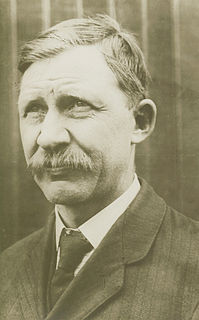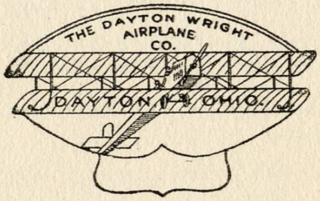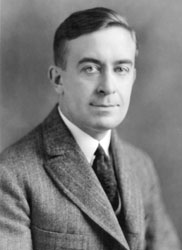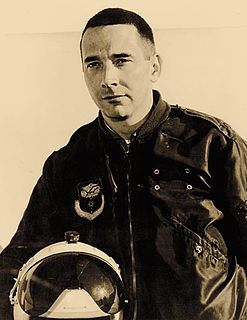Related Research Articles

The Wright brothers – Orville and Wilbur – were two American aviation pioneers generally credited with inventing, building, and flying the world's first successful motor-operated airplane. They made the first controlled, sustained flight of a powered, heavier-than-air aircraft with the Wright Flyer on December 17, 1903, 4 mi (6 km) south of Kitty Hawk, North Carolina. The brothers were also the first to invent aircraft controls that made fixed-wing powered flight possible.

Valhalla Memorial Park Cemetery is located at 10621 Victory Boulevard in North Hollywood and Burbank, California.
The Wright Company was the commercial aviation business venture of the Wright Brothers, established by them on November 22, 1909, in conjunction with several prominent industrialists from New York and Detroit with the intention of capitalizing on their invention of the practical airplane. The company maintained its headquarters office in New York City and built its factory in Dayton, Ohio.

Charles Edward Taylor was an American inventor, mechanic and machinist. He built the first aircraft engine used by the Wright brothers in the Wright Flyer, and was a vital contributor of mechanical skills in the building and maintaining of early Wright engines and airplanes.

Octave Chanute was a French-American civil engineer and aviation pioneer. He provided many budding enthusiasts, including the Wright brothers, with help and advice, and helped to publicize their flying experiments. At his death he was hailed as the father of aviation and the initial concepts of the heavier-than-air flying machine.

Gustave Albin Whitehead was an aviation pioneer who emigrated from Germany to the United States where he designed and built gliders, flying machines, and engines between 1897 and 1915. Controversy surrounds published accounts and Whitehead's own claims that he flew a powered machine successfully several times in 1901 and 1902, predating the first flights by the Wright Brothers in 1903.
This is a list of aviation-related events from 1901:

The Wright Flyer made the first sustained flight by a manned heavier-than-air powered and controlled aircraft—an airplane—on 17 December, 1903. Invented and flown by Orville and Wilbur Wright, it marked the beginning of the "pioneer era" of aviation.
The Wright Flyer III was the third powered aircraft by the Wright Brothers, built during the winter of 1904–05. Orville Wright made the first flight with it on June 23, 1905. The Flyer III had an airframe of spruce construction with a wing camber of 1-in-20 as used in 1903, rather than the less effective 1-in-25 used in 1904. The new machine was equipped with the engine and other hardware from the scrapped Flyer II and, after major modifications, achieved much greater performance than Flyers I and II.

Huffman Prairie, also known as Huffman Prairie Flying Field or Huffman Field is part of Ohio's Dayton Aviation Heritage National Historical Park. The 84-acre (34-hectare) patch of rough pasture, near Fairborn, northeast of Dayton, is the place where the Wright brothers undertook the difficult and sometimes dangerous task of creating a dependable, fully controllable airplane and training themselves to be pilots. Many early aircraft records were set by the Wrights at the Huffman Prairie.

The Wright Model A was an early aircraft produced by the Wright Brothers in the United States beginning in 1906. It was a development of their Flyer III airplane of 1905. The Wrights built about seven Model As in their bicycle shop during the period 1906–1907 in which they did no flying. One of these was shipped to Le Havre in 1907 in order to demonstrate it to the French. The Model A had a 35-horsepower (26 kW) engine and seating for two with a new control arrangement. Otherwise, it was identical to the 1905 airplane. The Model A was the first aircraft that they offered for sale, and the first aircraft design to enter serial production anywhere in the world. Apart from the seven machines the Wrights built themselves in 1906–1907, they sold licences for production in Europe with the largest number of Model As actually being produced in Germany by Flugmaschine Wright GmbH, which built about 60 examples.

Dayton Aviation Heritage National Historical Park is a United States National Historical Park in Dayton, Ohio that commemorates three important historical figures—Wilbur Wright, Orville Wright, and poet Paul Laurence Dunbar—and their work in the Miami Valley.

The Wright brothers designed, built and flew a series of three manned gliders in 1900–1902 as they worked towards achieving powered flight. They also made preliminary tests with a kite in 1899. In 1911 Orville conducted tests with a much more sophisticated glider. Neither the kite nor any of the gliders were preserved, but replicas of all have been built.

Augustus Roy Knabenshue was an American aeronautical engineer and aviator.

The Portal of the Folded Wings Shrine to Aviation is in Los Angeles, California. The shrine is a 75-foot-tall (23 m) structure of marble, mosaic, and sculpted figures and is the burial site for fifteen pioneers of aviation. Designed by Kenneth A. MacDonald Jr. and sculptor, Federico Augustino Giorgi, it was built in 1924 as the entrance to Pierce Brothers Valhalla Memorial Park Cemetery. Aviation enthusiast James Gillette was impressed by the rotunda's close proximity to the airport and Lockheed Aircraft Company. He conceived a plan to use the structure as a shrine to aviation and worked to that end for two decades. It was dedicated in 1953 by aviation enthusiasts who wanted a final resting place for pilots, mechanics, and other pioneers of flight.
Dedicated to the honored dead of American aviation on the 50th anniversary of powered flight, December 17, 1953, by Lieutenant General Ira C. Eaker USAF (retired). Beneath the memorial tablets in this sacred portal rest the cremated remains of famous flyers who contributed so much to the history and development of aviation. The bronze plaques upon the marble walls memorialize beloved Americans who devoted their lives to the advancement of the air age. Administered under the auspices of the Brookins–Lahm–Wright Aeronautical Foundation, this shrine stands as a lasting tribute.

The Dayton-Wright Company was formed in 1917, on the declaration of war between the United States and Germany, by a group of Ohio investors that included Charles F. Kettering and Edward A. Deeds of Dayton Engineering Laboratories Company (DELCO). Orville Wright lent his name and served as a consultant, but other than that, the location of one of its three factories in the original Wright Company factory buildings in Dayton, Ohio was the only connection to the Wright brothers. In addition to plant 3, Dayton-Wright operated factories in Moraine and Miamisburg, Ohio. During the course of the war, Dayton-Wright produced about 3,000 DH-4s, as well as 400 Standard SJ-1 trainers. The company was hurt by the reputation of the DH-4s it produced as "flaming coffins" or "flying coffins", although they were not in reality more subject to catching fire than other aircraft, and by scandals it faced.

Alfred Victor Verville was an American aviation pioneer and aircraft designer who contributed to civilian and military aviation. During his forty-seven years in the aviation industry, he was responsible for the design and development of nearly twenty commercial and military airplanes. Verville is known for designing flying boats, military racing airplanes, and a series of commercial cabin airplanes. His planes were awarded with the Pulitzer Speed Classic Trophy in 1920 and 1924.

Walter J. Boyne was a United States Air Force officer, Command Pilot, combat veteran, aviation historian, and author of more than 50 books and over 1,000 magazine articles. He was a director of the National Air and Space Museum of the Smithsonian Institution and a Chairman of the National Aeronautic Association.
Gerald Shea "Jerry" Sharkey was an American historic preservationist and historian of the Wright brothers, who conceived the idea for the Dayton Aviation Heritage National Historical Park in Dayton, Ohio. The Dayton Aviation Heritage National Historical Park, which preserves historic sites used by the Wright Brothers throughout Dayton, was established in 1992. Sharkey had led an alliance of the Wright family, members of the U.S. House of Representatives, the local media and U.S. Federal Judge Walter H. Rice to create the national historical park. Many of the sites associated with the Wight brothers would likely have been demolished if not for the preservation efforts spearheaded by Sharkey. According to Tom Crouch, a senior curator of aeronautics at the National Air and Space Museum in Washington, D.C., Sharkey's efforts helped to "ensure that what the Wright brothers achieved wouldn't be forgotten." Despite his enthusiasm for the Wright brothers and their work, Sharkey was reportedly afraid of flying.
Several aviators have been claimed as the first to fly a powered aeroplane. Much controversy has surrounded these claims. It is most widely held today that the Wright brothers were the first to fly successfully; they methodically studied every aspect of flight, and achieved masterful control of their aircraft. Brazil regards Alberto Santos-Dumont as the first successful aviator because the Wright Flyer took off from a rail. An editorial in Jane's All the World's Aircraft's 2013 edition supported the claim of Gustave Whitehead.
References
- 1 2 "Marriage Record". County Marriage Records (9903). Greene County, Ohio. November 2, 1963.
- 1 2 Tom D. Crouch CV at the National Air and Space Museum - Smithsonian
- 1 2 Tom D. Crouch at the SIA archives.
- ↑ Gaffney, Timothy R (October 14, 1999). "Dreams of Wings - Boy who loved planes has made a life as keeper of nation's aviation history". Dayton Daily News. p. 1C.
- ↑ Turner, Brett (August 28, 2013). "Eyes fixed on the skies at 2013 Fair at New Boston". Springfield News-Sun. Retrieved February 25, 2017.
- ↑ "Tecumseh Local Schools Hall of Honor Members" (PDF). Retrieved February 25, 2017.
- 1 2 3 Tom D. Crouch bio at www.sil.si.edu.
- ↑ "Portal of the Folded Wings Shrine to Aviation". Archived from the original on 2007-08-16. Retrieved 2007-09-25.
In 1924, architect Kenneth MacDonald, Jr., and sculptor Federico Giorgi built the Valhalla Memorial Rotunda, a structure now known as The Portal of the Folded Wings - Shrine to Aviation, on the eastern edge of this property. Originally intended to be the entrance to Valhalla Memorial Park, visitors drove through the arches via Valhalla Drive, off Hollywood Way. The Rotunda, with its graceful garden walls and three reflection pools, became a tourist attraction and was used for musical concerts, radio broadcasts and other public events during the 1920s and 1930s.
- ↑ "Resting Place for Early Aviators Gets a New Look". Daily News of Los Angeles. April 1, 1996.
They were among America's aviation pioneers - men and women who flew around the world in rickety contraptions at the turn of the century, undaunted by fear and seduced by the skies. In life, they were united by their love of adventure. Today, many of them are still together - interred in an obscure monument in a North Hollywood cemetery, directly under the takeoff path for Burbank Airport. Located in a corner of the Pierce Brothers Valhalla Memorial Park and Mortuary, the